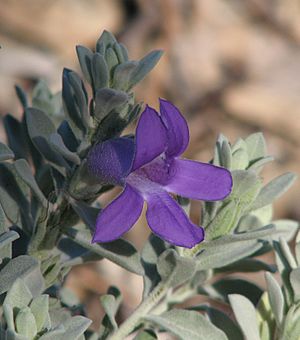Eremophila hygrophana facts for kids
Quick facts for kids Eremophila hygrophana |
|
|---|---|
 |
|
| Eremophila hygrophana in Royal Botanic Gardens, Cranbourne, Melbourne | |
| Scientific classification | |
| Genus: |
Eremophila (plant)
|
| Species: |
hygrophana
|
Eremophila hygrophana is a beautiful flowering plant that belongs to the figwort family, called Scrophulariaceae. It grows only in Australia, which means it's endemic there. This plant is a compact, upright shrub with lots of crowded, grey leaves and pretty violet or purple flowers. You can find it growing naturally in South Australia and Western Australia.
Contents
What it Looks Like
Eremophila hygrophana is an upright, bushy shrub that grows to be about 0.3 and 1.2 m (1 and 4 ft) tall. Its leaves and branches are covered with tiny hairs, some of which are sticky (glandular) and others are yellow or grey and branched. As the plant gets older, the lower parts of its branches feel rough because of old leaf bases. The leaves grow close together at the ends of the branches. They are furry, thick, and shaped like a line or a spear. Most leaves are 12–25 mm (0.5–1 in) long and 2.5–5 mm (0.1–0.2 in) wide.
Flowers and Fruits
The flowers grow one by one where the leaves meet the stem, and they don't have a stalk. Each flower has 5 green, hairy, triangle-shaped parts called sepals, which are 6.5–12 mm (0.3–0.5 in) long. The petals are 20–30 mm (0.8–1 in) long and join together at the bottom to form a tube. The outside of the flower tube is pale violet to purple, while the inside is lighter with purple spots. As the flowers get older, their color changes to a dark reddish-brown. The outside of the tube and the petal tips are hairy, but the inside of the tips is smooth, and the inside of the tube is woolly. The four stamens (the parts that make pollen) are completely hidden inside the petal tube.
This plant flowers from July to December. After the flowers, it produces oval or cone-shaped fruits that are 6–8 mm (0.2–0.3 in) long and covered with hairs.
How it Got its Name
Eremophila hygrophana was first officially described by a scientist named Robert Chinnock in 2007. He published its description in a book called Eremophila and Allied Genera: A Monograph of the Plant Family Myoporaceae. The second part of its name, hygrophana, comes from Ancient Greek words. These words mean "changing color during the drying process," which describes how the flowers change color as they age.
Where it Grows
This type of eremophila plant is most common in Western Australia. You can find it growing from near Rawlinna all the way to Mount Magnet. It lives in different natural areas like the Gibson Desert, Little Sandy Desert, Murchison, Nullarbor Plain, and Yalgoo regions. It also grows in the very central-west part of South Australia. There's one record of it in the Northern Territory, but that might be a new kind of plant that hasn't been named yet.
Conservation Status
The Western Australian Government's Department of Parks and Wildlife says that Eremophila hygrophana is "not threatened." This means it's not currently in danger of disappearing.
Growing it in Gardens
This small eremophila is one of the most beautiful plants to grow in a garden. It has lovely furry leaves, sometimes golden, and large purple flowers that bloom for most of the year. It grows especially well in Melbourne. A specific type, called "Blue Bells," is very popular in gardens in drier parts of the United States.
You can start new plants from cuttings (small pieces of the plant) taken during warm weather. You can also grow it by grafting it onto the rootstock of another plant called Myoporum. Grafted plants often do better in heavy soils. This plant can handle dry conditions but doesn't like too much humidity. So, it prefers a sunny, open spot in the garden. It can also handle a little bit of frost, but you might need to trim off any branches that get damaged by the cold.
Images for kids
-
E. hygrophana growing near Wiluna




